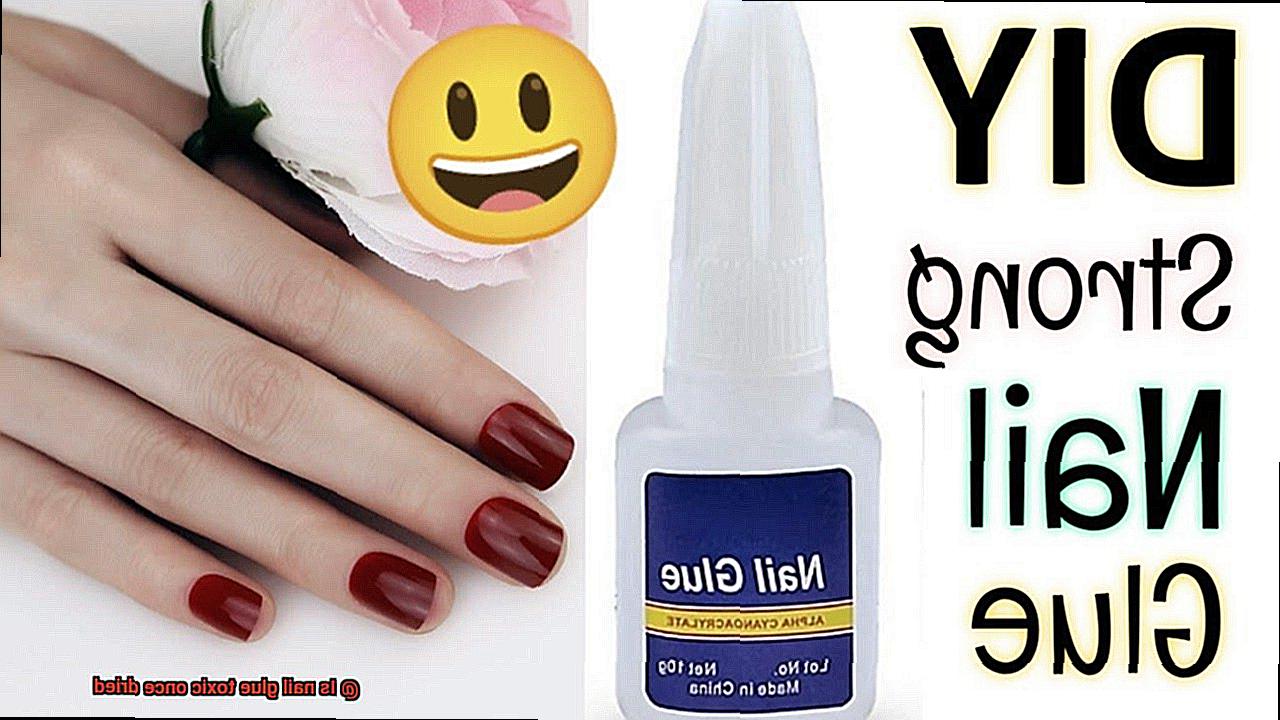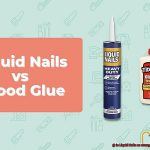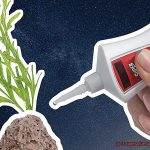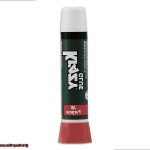Are you a nail art enthusiast who can’t resist the allure of nail glue? This sticky solution is a must-have for attaching artificial tips, rhinestones, and other embellishments to your nails. But wait, have you ever wondered if nail glue is safe for your health? Specifically, does it become toxic once dried?
Nail glue contains chemicals such as cyanoacrylate that can lead to skin irritation and allergies. Moreover, the fumes released during application can cause headaches, breathing difficulties, and eye irritation. However, what we’re really concerned about is whether the adhesive remains hazardous once it dries on your nails.
In this blog post, we’ll delve into the true nature of nail glue and explore whether it poses any health risks after drying. We’ll also provide tips on how to minimize potential harm and suggest safe alternatives for those with sensitive skin. So whether you’re a seasoned user of nail glue or just curious about its potential hazards, keep reading to find out if this adhesive is indeed toxic once dried.
What is Nail Glue?
Contents
- 1 What is Nail Glue?
- 2 Is Nail Glue Toxic Before it Dries?
- 3 Is Nail Glue Toxic Once it Dries?
- 4 What are the Potential Health Risks of Nail Glue?
- 5 How to Safely Use Nail Glue
- 6 Tips for Avoiding Ingestion or Inhalation of Nail Glue
- 7 Are There Different Types of Nail Glue That May be More or Less Toxic?
- 8 Are There Alternatives to Using Nail Glue?
- 9 Conclusion
This fast-drying adhesive is specifically designed for use on nails and is made from a combination of cyanoacrylate and other chemicals that help to form a strong and durable bond between the natural nail and the artificial nail or design.
Nail glue is a versatile and effective adhesive that can be used for a variety of different applications in the world of nail care and design. Its strength, durability, and fast-drying properties make it a popular choice among professionals and DIY enthusiasts alike.
One of the primary benefits of nail glue is its ability to bond quickly and securely to the natural nail. This makes it an ideal choice for those who want to apply artificial nails or create intricate nail art designs that require precision and stability. But beyond its bonding capabilities, nail glue also offers a range of other benefits.
- Easy to Use: Nail glue is incredibly easy to use, even for beginners. Simply apply a small amount of glue to the natural nail, place the artificial nail or design on top, and hold in place for a few seconds until the glue dries.
- Versatile: Nail glue can be used for a variety of different applications in the world of nail care and design. Whether you’re applying artificial nails, creating intricate designs with rhinestones or studs, or simply repairing a broken nail, nail glue can do it all.
- Long-Lasting: Thanks to its strong bonding properties, nail glue creates a long-lasting hold that can withstand daily wear and tear. This means that your manicure or nail art design will look great for days or even weeks on end.
However, it’s important to note that nail glue should only be used as directed and with proper precautions. While cyanoacrylate can be safe when used properly, it can also be harmful if ingested or inhaled. Additionally, some nail glues may contain other harmful chemicals that can cause respiratory problems or other health issues.
Is Nail Glue Toxic Before it Dries?
Nail glue is a fantastic tool for attaching artificial nails to natural nails or repairing broken nails. However, as an expert in the field, I am here to tell you that it can be toxic when it’s wet. Before we delve into the details, let’s start with the basics.
The primary ingredient in nail glue is ethyl cyanoacrylate, which is a type of cyanoacrylate compound known for its strong bonding properties. These compounds can be toxic if they come into contact with the skin or eyes. Therefore, it’s essential to handle nail glue with care and avoid direct contact with the skin.
When nail glue is still wet, it can be toxic if ingested or inhaled. The fumes from the glue can cause irritation to the eyes, nose, and throat. If ingested, it can cause nausea, vomiting, and abdominal pain. As such, using nail glue in a well-ventilated area is essential.
But don’t worry. Once nail glue has dried, it is generally considered safe. This means that once the glue has formed a hard and non-toxic layer, it does not release toxic fumes or chemicals. However, you should still avoid biting or chewing on the glued nails as this could potentially cause ingestion of the adhesive.
Here are some tips to help you handle nail glue safely:
- Use in a well-ventilated area: This will help to minimize any potential inhalation of fumes from the glue.
- Avoid direct contact with skin: If you do accidentally get nail glue on your skin, wipe it off immediately with a cloth or tissue.
- Keep out of reach from children and pets: Nail glue should always be stored in a safe place where children and pets cannot access it.
- Don’t chew on glued nails: As I mentioned earlier, this could lead to ingestion of the adhesive.
Is Nail Glue Toxic Once it Dries?
Well, let me put your mind at ease – once dried, nail glue is generally considered safe.
The primary ingredient in nail glue is cyanoacrylate, an acrylic resin that bonds quickly and strongly to surfaces. However, when cyanoacrylate comes into contact with moisture, it polymerizes, creating a strong adhesive bond. While this can be irritating to the skin and eyes when wet, it becomes non-toxic once dry.
Here are some important points to keep in mind:
- Inert and Non-Toxic: Once the nail glue has dried, it becomes inert and non-toxic. This means that accidental ingestion or inhalation of dried nail glue should not cause harm. However, if you experience any adverse reactions such as redness, swelling or itching, seek medical attention immediately.
- Read the Label: Not all nail glues are created equal. Some contain additional chemicals or additives that may be harmful if ingested or inhaled. It is crucial to read the label and use nail glue as directed.
- Consult with a Healthcare Professional: If you have concerns about the safety of a particular nail glue product, it is advisable to consult with a healthcare professional or toxicologist.
What are the Potential Health Risks of Nail Glue?
If you’re a fan of the convenience and glamour that nail glue offers, there are some potential health risks to keep in mind. Nail glue is typically made from a mixture of chemicals, including cyanoacrylate, which is known for its strong adhesive properties. While this may seem like a great solution for keeping your nails in place, it can have negative effects on your health if not used properly.
Firstly, one of the main concerns with nail glue is that it can cause an allergic reaction. Cyanoacrylate has the ability to bond with proteins in your skin, which can lead to an immune response. This could result in redness, itching, swelling, or even blisters and sores. It’s essential to read the label and seek medical attention if necessary.
Secondly, ingestion of nail glue can be harmful, especially for young children who may accidentally swallow it. Ingesting nail glue can cause severe damage to the digestive system, including the esophagus and stomach. So it’s important to keep it out of reach from children and pets.
Finally, long-term exposure to nail glue fumes can also pose a risk to your health. The fumes can irritate your eyes, nose, and throat and even lead to respiratory problems over time. If you work with nail glue often, taking precautions such as working in a well-ventilated area and wearing protective gear like gloves and a mask is crucial.
How to Safely Use Nail Glue
Nail glue is a popular beauty product that can make your nails look great. However, it is important to use it safely to avoid any potential harm. Here are five sub-sections that explain how to safely use nail glue.
Choose the Right Nail Glue
When selecting nail glue, ensure that you choose one specifically designed for nails. Using other types of glue, such as superglue or household adhesives, can be dangerous and potentially toxic. Look for nail glues labeled as “non-toxic” or “safe for natural nails.”
Use in a Well-Ventilated Area
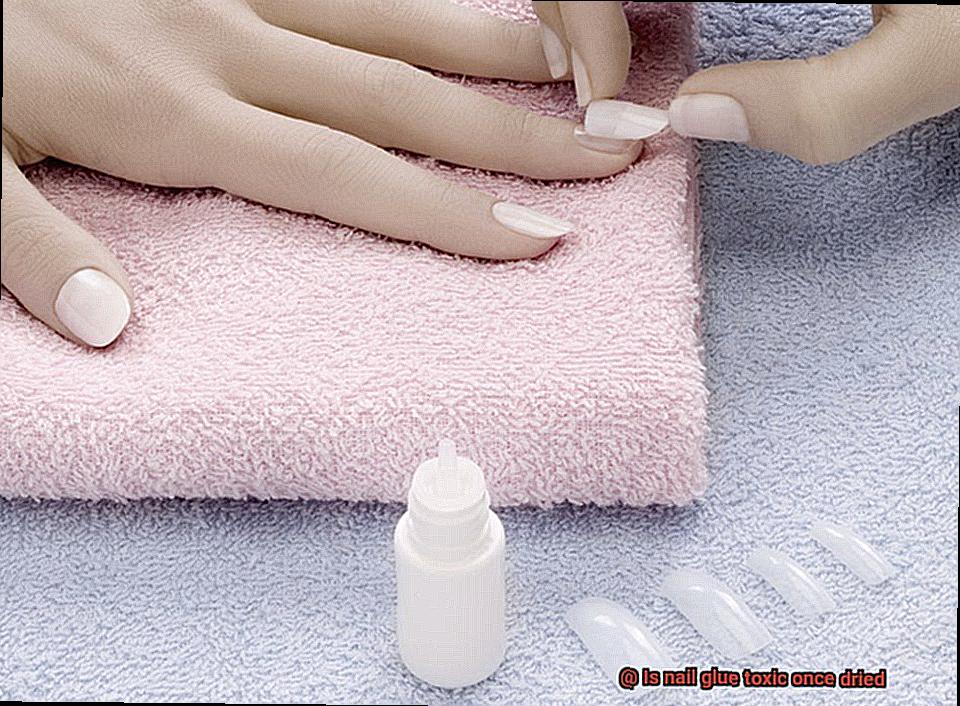
Before applying the glue, ensure that you are in a well-ventilated area. This will help prevent any fumes from accumulating and potentially causing harm. If possible, open a window or use a fan to increase air circulation.
Apply Only a Small Amount of Glue
Less is more when it comes to using nail glue. Use only a small amount and avoid getting it on your skin. If you accidentally get glue on your skin, wash it off immediately with soap and water.
Store Properly
To keep your nail glue fresh and safe, store it in a cool, dry place away from heat sources and direct sunlight. Also, keep it out of reach of children and pets.
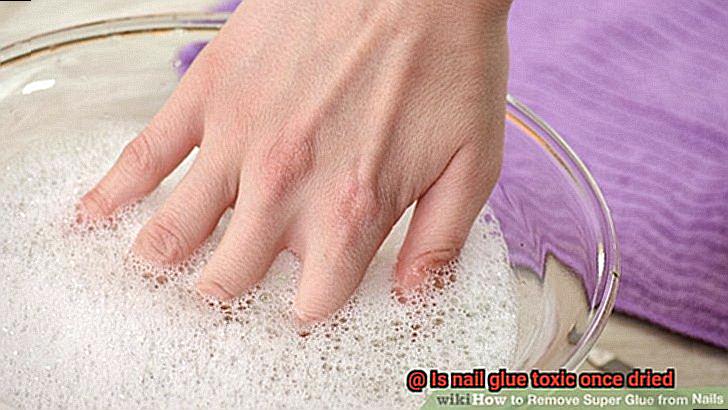
Check the Label for Harmful Chemicals
Some nail glues may contain harmful chemicals such as formaldehyde, toluene, and dibutyl phthalate (DBP). These chemicals can be toxic if they are inhaled or absorbed through the skin. Make sure to read the label carefully and choose a product that does not contain harmful chemicals.
In addition to these tips, it is essential to follow a few additional safety measures when using nail glue. For example, do not attempt to peel or scrape off the glue from your skin, as this can cause damage to your skin. Instead, wash it off immediately with soap and water.
Tips for Avoiding Ingestion or Inhalation of Nail Glue
Nail glue is a powerful adhesive that is commonly used in manicures and pedicures to attach artificial nails or to fix a broken nail. However, it can be toxic if ingested or inhaled. Here are some vital tips for avoiding ingestion or inhalation of nail glue:
Firstly, use the glue in a well-ventilated area. This means avoiding small and enclosed spaces such as bathrooms or closets. It is recommended that you use it near an open window or in a room with a fan. This will help to ensure that any harmful fumes are quickly dispersed, reducing the risk of inhaling them.
Secondly, always be careful when applying the glue. Applying too much at once can cause excess glue to spill onto your skin or clothes, increasing the risk of accidental ingestion or inhalation. Use only a small amount of glue at a time and be careful not to let it spread too far outside the nail.
Thirdly, keep nail glue out of reach of children and pets. Many cases of accidental ingestion or inhalation occur when young children or animals get hold of the glue. Always store your nail glue in a secure place where children and pets cannot access it.
Fourthly, read the label on the nail glue carefully. The label provides important information about the potential risks and how to safely use the product. It is essential to understand how long it takes to dry and how to remove it if necessary.
Finally, store your nail glue properly. Nail glue should be stored in a cool, dry place away from direct sunlight. It should also be kept away from sources of heat and flame, which can cause it to ignite or release harmful fumes.
Are There Different Types of Nail Glue That May be More or Less Toxic?
Nail glue is a popular adhesive used for nail extensions or repairs. However, not all nail glues are created equal, and some can be more toxic than others. Let’s dive deeper into the different types of nail glue and how they can affect toxicity levels.
Cyanoacrylate-based Nail Glue:
The most common type of nail glue is cyanoacrylate-based glue, also known as “super glue.” This adhesive bonds quickly and strongly when exposed to air and is available in both liquid and gel forms. While cyanoacrylate-based glues are generally safe for use in small amounts, they can be toxic if ingested or if it comes into contact with sensitive areas like the eyes or mouth. Additionally, some people may be allergic to cyanoacrylate glue, which can cause skin irritation or other allergic reactions.
Methacrylate-Based Nail Glue:
Methacrylate-based nail glue is another commonly used type of adhesive that is known for its strong bonding properties. It is often used in salons, but it can be more toxic than other types of nail glues, especially if it contains methyl methacrylate (MMA). MMA has been linked to various health concerns such as skin irritation, respiratory problems and cancer.
Non-Toxic Nail Glue:
Recently, there has been a trend towards using more natural and non-toxic nail glues. These types of adhesives are typically made from plant-based ingredients and are free from harsh chemicals like formaldehyde and toluene. While non-toxic nail glues may not be as strong as traditional nail glues, they offer a safer and more eco-friendly alternative for those who are concerned about the potential risks associated with traditional nail glues.
Choosing the Right Nail Glue:
When selecting a nail glue product, it’s important to choose a high-quality product that is free from harmful chemicals and has been tested for safety. It’s also essential to read the label carefully before purchasing any nail glue product. Some products may contain formaldehyde, which is a known carcinogen and can cause skin irritation or allergic reactions. Other potentially harmful ingredients include toluene, acetone, ethyl acetate, and butyl acetate, which can cause headaches, dizziness, and nausea if inhaled or ingested.
Safety Precautions:
It’s important to use nail glue in a well-ventilated area and avoid inhaling or ingesting any fumes or residue from the glue. If you experience any adverse reactions such as skin irritation or difficulty breathing, seek medical attention immediately.
Are There Alternatives to Using Nail Glue?
Fear not, because there are safe and effective alternatives that you can use instead. As an expert in this field, I am excited to share with you some of the alternative options that you can consider for your next manicure.
Firstly, adhesive tabs or stickers are an excellent option for those who want to avoid traditional nail glue. These products are easy to use and come in various sizes and shapes, making them a suitable choice for various artificial nails. Adhesive tabs are especially popular among those who want to avoid the mess and potential hazards associated with traditional nail glue. They are also easy to remove without causing any damage to your natural nails.
Another great alternative is non-toxic nail adhesives. These adhesives are made with natural ingredients such as water-based polymers or soy-based resins, which may be less harmful than the chemicals found in traditional nail glue. Non-toxic adhesives are designed to be gentle on your nails and skin, making them an excellent choice for individuals with sensitive skin.
In addition to adhesive tabs and non-toxic adhesives, magnetic or clip-on artificial nails are also becoming increasingly popular. These types of artificial nails do not require any adhesive at all, making them a great option for those who want to avoid any potential harm caused by traditional nail glue. Magnetic or clip-on artificial nails can be easily applied and removed without causing any damage to your natural nails.
igNPtL5tp4w” >
Conclusion
In the world of nail care and design, nail glue is a go-to adhesive for many. Although it can be safe when used correctly, it’s important to consider potential health risks, especially when dealing with wet glue. The chemical composition of nail glue includes cyanoacrylate, which can cause skin irritation and allergies. Additionally, fumes released during application can lead to headaches, breathing difficulties, and eye irritation.
However, once the glue has dried on your nails, you can breathe easy knowing that it’s generally considered safe and non-toxic. It becomes inert and doesn’t release any toxic fumes or chemicals. Nonetheless, it’s crucial to follow safety precautions such as using it in a well-ventilated area and avoiding ingestion or inhalation.
If you’re worried about traditional nail glue’s potential risks, don’t fret. There are safe alternatives available such as adhesive tabs or stickers made with natural ingredients or magnetic or clip-on artificial nails.
Always remember to read the label carefully before purchasing any nail glue product and seek medical attention immediately if you experience any adverse reactions such as skin irritation or difficulty breathing.

